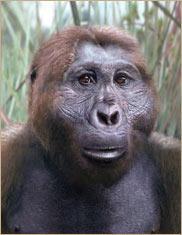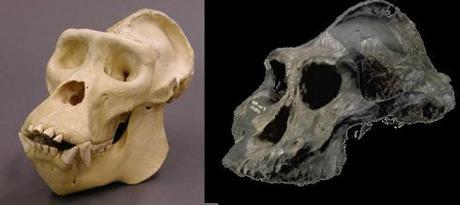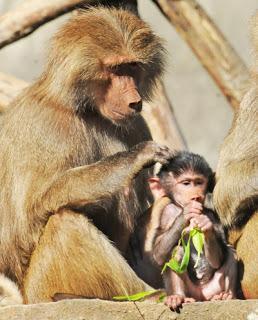
Paranthropines are a weird offshot of humanity
Paranthropus is a strange off-shoot of humanity that split from our lineage 3 – 4 million years ago. They’re famously bizarre, having a crest on the top of their skull, huge teeth and an even bigger jaw. These features earned the first Paranthropine discovered the nickname “nut cracker man” (Boyd and Silk, 2009).
Despite this, subsequent research has revealed that they didn’t actually eat a lot of nuts. Micorwear analysis of their teeth shows they actually had a very soft diet whilst the isotopes in their bones shed light on just what these soft foods were (different food sources contain different ratios of isotopes. Marine food, for example, tends to have more of one isotope of Nitrogen than terrestrial food sources). Examining the isotopes present in Paranthropus boisei indicates they were eating grasses and/or sedges (Sponheimer et al., 2006).
Although grasses (and/or sedges) aren’t particularly hard they are very tough and would require a lot of chewing to grind them up. They’re also quite low calorie foods, so the Paranthropines would probably have to have eaten a lot of them to survive. Thus Paranthropus would’ve had to have spent a lot of time chewing, which would explain their huge jaws: they give them the stamina to do so (Cerling et al., 2011).
It would seem Paranthropus was almost a “human cow”, spending their days chewing plant matter. Gorillas live of leaves, which is another type of tough, low calorie food. As such they face the same problems Paranthropus would have and – like Paranthropus - they’ve developed a crest and large jaws.

A gorilla skull (left) and Paranthropus aethopicus skull (right). Key similarities include a crest on-top of the skull, flared cheekbones and large mandible (not shown)
However, some researchers think that the “cow” hypothesis doesn’t explain every bizarre part of Paranthropus. In particular, they argue that it cannot explain why teeth were unusually large and had very thick enamel (together called megadontia). These researchers point out that megadontia is only present in modern species that eat very hard food. Like nuts (Yeakel et al., 2013).
So is Paranthropus “nut cracker man” after all? These dissidents don’t think so. Rather, they point out that roots and tubers (known as underground storage organs or “USOs”) both very hard and would’ve been quite common in the environments Paranthropines inhabited. They’re also often eaten by many species living in these environments today (Laden and Wrangham, 2005). But if they were regularly eating these USOs, why don’t their teeth have the microwear scratches that result from eating hard food?

Baboons live in a similar environment to Paranthropus and also eat USOs
A new paper investigates this contradiction by simulating the circumstances under which USOs would become the preferred food choice for humans with megadontia. This simulation revealed that Paranthropus would not have been eating USOs year round. In fact, they only really became a viable option during very dry periods where most other food sources disappeared. Their simulation also found that when they ate grasses, they probably preferred the seeds rather than the leaves.
In other words, USOs were a “fall-back food” Paranthropus survived off during droughts. As such their megadontia was not an adaptation to help them with their every day diet but a last line of defence in case of extreme environmental conditions. This would also explain why there’s little isotopic and microwear evidence for eating hard foods: these lines of evidence only detect diet over the course of a lifetime. A short period of eating hard foods won’t be recorded (Yeakel et al., 2013).
Of course, this does mean it’s rather difficult to test their simulation against real world data. That said, it isn’t the only investigation to suggest USOs were fall-back foods, suggesting that their results should not be dismissed (Laden and Wrangham, 2005). Nonetheless, a degree of skepticism is warranted until someone figures out a way to double check their simulation with actual, physical analyses.
So it would seem the diet of Paranthropus is surprisingly varied, which raises a whole host of interesting questions. For example, it was long assumed that their reliance on one type of food made them vulnerable to environmental change and unable to compete with more versatile species (Grove, 2012). If they were capable of living off these fall-back foods, why did they die out?
And do we, like the Paranthropines, have any adaptations that aren’t intended for every day use? Although our molars are much smaller than those of the human cows, we still have much thicker enamel than most living apes. Are we also adapted for fall-back foods?
Despite being over 50 years old Paranthropus is still finding ways to surprise us. I guess it just proves the old biology saying: “evolution is smarter than you.”
References
Boyd, R., & Silk, J. B. (2009). How Humans Evolved. WW Norton & Company, New York.
Cerling, T. E., Mbua, E., Kirera, F. M., Manthi, F. K., Grine, F. E., Leakey, M. G., … & Uno, K. T. (2011). Diet of Paranthropus boisei in the early Pleistocene of East Africa. Proceedings of the National Academy of Sciences, 108(23), 9337-9341.
Grove, M. (2012). Amplitudes of orbitally induced climatic cycles and patterns of hominin speciation. Journal of Archaeological Science, 39(10), 3085-3094.
Laden, G. and R. Wrangham, 2005. The rise of the hominids as an adaptive shift in fallback foods: plant underground storage organs (USOs) and australopith origins. Journal of Human Evolution 49:482–498
Sponheimer, M., Passey, B. H., De Ruiter, D. J., Guatelli-Steinberg, D., Cerling, T. E., & Lee-Thorp, J. A. (2006). Isotopic evidence for dietary variability in the early hominin Paranthropus robustus. Science, 314(5801), 980-982.
Yeakel, J. D., Dominy, N. J., Koch, P. L., & Mangel, M. (2013). Functional morphology, stable isotopes, and human evolution: a model of consilience.Evolution.

